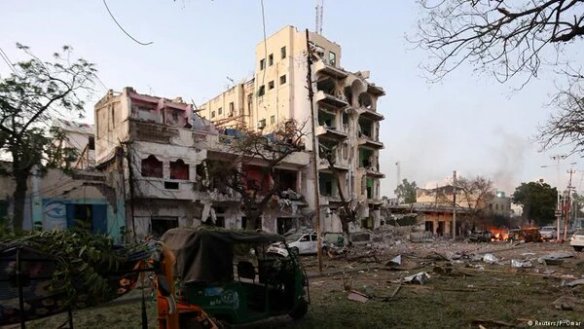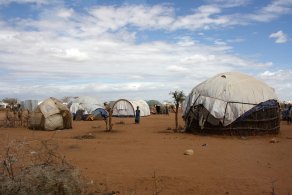As the blessed month of Ramadan begins, many here in Mogadishu are concerned about the security situation, with talks of increased numbers of Al-Shabaab insurgents entering the city in preparation of carrying out attacks.

“Do not be fooled by this city. For it may look normal, but what you see is an illusion. The reality is that the security is so fragile”
Driving through the Makka Al Mukram road, considered to be in the safe zone, that is, in the government controlled area, you will see the destruction and havoc that was caused by Al-Shabaab less than a week ago. They attacked the Ambassador Hotel, which resulted not only in the deaths of two prominent members of the Federal Parliament, but countless civilians. The government claims that the death toll was 24, but what is left of this building and its surroundings tells an entirely different story. Many of us heard the continuous gunfight and explosives that lasted throughout the night and into the early hours of the morning. Many of us were up for the morning prayers as we continued to hear the ongoing battle between government forces and Al-Shabaab fighters.
As I sat eating my breakfast, the continuous battle relegated to background noise, I was reminded of what I was told by a fellow diaspora when I first arrived in Mogadishu, three years ago:
‘do not be fooled by this city for it may look normal but what you see is an illusion. The reality is that the security is so fragile’.
It appears, however, that many continue to fall for this illusion of a safe Somalia, with countries like Norway now readying the grounds for forcibly returning failed asylum seekers to Mogadishu. In utmost secrecy, the Norwegian government through talks between the Norwegian Minister of Foreign Affairs Børge Brende and the Somali Minister of Foreign Affairs Abdusalam Omer, has prepared a return agreement with Somalia. If the agreement goes through, 500 Somalis who have been denied permanent residence are at risk of being forcibly returned to Somalia.

Refugee shelters in the Dadaab camp, northern Kenya (2011). Photo: Pete Lewis/Department for International Development, UK
Considering the sheer numbers, it is even more alarming to hear of Kenya’s decision to forcefully shut down Dadaab, the world’s largest refugee camp, with a current estimate of anything between 300,000 to 340,000 refugees. Kenya cites ‘national security’, once again linking vulnerable refugees that they are bound to protect by law, to terrorism and insecurity within Kenya. Scapegoating Somali refugees only fuels xenophobia towards Somalis in Kenya.
Kenya’s decision violates national, regional and international legal obligations to protect refugees. The tripartite agreement between the Kenyan government, the Somali government and UNHCR comes to an end in November this year. This agreement allowed for the voluntary repatriation of Somali refugees over a three-year period. On June 7, 2016 the President of Kenya and the President of the Federal Republic of Somalia met to discuss this issue, amongst other issues. Whilst the communiqué refers to the tripartite agreement, it is very vague on what has been agreed and the focus is still very much on the repatriation of Somali refugees. Thus, Kenya’s decision to shut down Dadaab will not lead to voluntary repatriation, but instead the forcible return of vulnerable refugees to the very place they once fled from. As talks continue between the Kenyan government and the international community, there is little doubt that scare tactics continue to be used forcing many to leave the refugee camp. In this context, distinguishing forced returns with people returning out of their own volition is not an easy task.
Furthermore, Kenya has bypassed the Somali government and has been in talks with the Jubbaland Administration, a member state of the Federal Republic of Somalia, to repatriate many of the refugees from Dadaab. Jubbaland Administration is one of the recently established member states and it is unrealistic that they would have the capacity to absorb such a large number of refugees. Moreover, the Jubbaland authorities are not in charge of all areas of Jubbaland, with some areas still under Al-Shabaab control. The Somali government is also in no position to provide any returnees with safety and protection. There are an estimated 1.1 million Internally Displaced Persons (IDPs) throughout Somalia without shelter, livelihood and protection. In bigger cities, they continue to be evicted by the government and private landlords.
We explore the relationship between aid and protection in the article ‘Governing Mobility through Humanitarianism in Somalia: Compromising Protection for the Sake of Return’, which I co-authored with PRIO-researcher Cindy Horst. Based on research conducted with Somali refugees in Kenya and IDPs in South Central Somalia and Somaliland, we argue that mobility is central to the protection strategies of displaced Somalis and that humanitarian approaches are often not relevant to the mobile everyday realities of the displaced Somalis nor protective of them. Most importantly, we argue that the policy focus of regional and international donors and states on the return of displaced individuals, is implemented by humanitarian agencies as their funding depends on this outcome. These are the very agencies entrusted in ensuring the safety and protection of the displaced, thus severely compromising their position as neutral humanitarian actors.
Amidst ongoing discourses on migration and refugee issues in Europe and globally, in the case of Dadaab, it is important to focus on the plight of the thousands and thousands of people that are left in limbo on the borders of Kenya and Somalia. As migration management interests of regional and international actors increasingly coincide, these individuals will not be able to feel safety and security in either of the two countries.